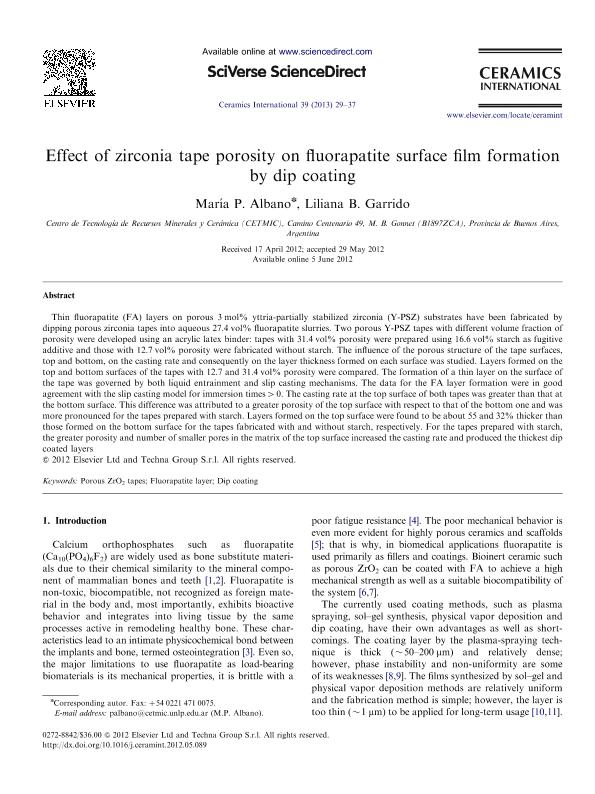Mostrar el registro sencillo del ítem
dc.contributor.author
Albano, Maria Patricia

dc.contributor.author
Garrido, Liliana Beatriz

dc.date.available
2017-09-13T13:30:51Z
dc.date.issued
2013-01
dc.identifier.citation
Albano, Maria Patricia; Garrido, Liliana Beatriz; Effect of zirconia tape porosity on fluorapatite surface film formation by dip coating; Elsevier; Ceramics International; 39; 1; 1-2013; 29-37
dc.identifier.issn
0272-8842
dc.identifier.uri
http://hdl.handle.net/11336/24105
dc.description.abstract
Thin fluorapatite (FA) layers on porous 3 mol% yttria-partially stabilized zirconia (Y-PSZ) substrates have been fabricated by dipping porous zirconia tapes into aqueous 27.4 vol% fluorapatite slurries. Two porous Y-PSZ tapes with different volume fraction of porosity were developed using an acrylic latex binder: tapes with 31.4 vol% porosity were prepared using 16.6 vol% starch as fugitive additive and those with 12.7 vol% porosity were fabricated without starch. The influence of the porous structure of the tape surfaces, top and bottom, on the casting rate and consequently on the layer thickness formed on each surface was studied. Layers formed on the top and bottom surfaces of the tapes with 12.7 and 31.4 vol% porosity were compared. The formation of a thin layer on the surface of the tape was governed by both liquid entrainment and slip casting mechanisms. The data for the FA layer formation were in good agreement with the slip casting model for immersion times>0. The casting rate at the top surface of both tapes was greater than that at the bottom surface. This difference was attributed to a greater porosity of the top surface with respect to that of the bottom one and was more pronounced for the tapes prepared with starch. Layers formed on the top surface were found to be about 55 and 32% thicker than those formed on the bottom surface for the tapes fabricated with and without starch, respectively. For the tapes prepared with starch, the greater porosity and number of smaller pores in the matrix of the top surface increased the casting rate and produced the thickest dip coated layers.
dc.format
application/pdf
dc.language.iso
eng
dc.publisher
Elsevier

dc.rights
info:eu-repo/semantics/openAccess
dc.rights.uri
https://creativecommons.org/licenses/by-nc-sa/2.5/ar/
dc.subject
Porous Zro2 Tapes
dc.subject
Fluorapatite Layer
dc.subject
Dip Coating
dc.subject.classification
Compuestos

dc.subject.classification
Ingeniería de los Materiales

dc.subject.classification
INGENIERÍAS Y TECNOLOGÍAS

dc.title
Effect of zirconia tape porosity on fluorapatite surface film formation by dip coating
dc.type
info:eu-repo/semantics/article
dc.type
info:ar-repo/semantics/artículo
dc.type
info:eu-repo/semantics/publishedVersion
dc.date.updated
2017-08-29T19:57:31Z
dc.journal.volume
39
dc.journal.number
1
dc.journal.pagination
29-37
dc.journal.pais
Países Bajos

dc.journal.ciudad
Amsterdam
dc.description.fil
Fil: Albano, Maria Patricia. Provincia de Buenos Aires. Gobernación. Comision de Invest.científicas. Centro de Tecnología de Recursos Minerales y Ceramica. Consejo Nacional de Investigaciones Científicas y Técnicas. Centro Científico Tecnológico Conicet - la Plata. Centro de Tecnología de Recursos Minerales y Ceramica; Argentina. Consejo Nacional de Investigaciones Científicas y Técnicas; Argentina
dc.description.fil
Fil: Garrido, Liliana Beatriz. Provincia de Buenos Aires. Gobernación. Comision de Invest.científicas. Centro de Tecnología de Recursos Minerales y Ceramica. Consejo Nacional de Investigaciones Científicas y Técnicas. Centro Científico Tecnológico Conicet - la Plata. Centro de Tecnología de Recursos Minerales y Ceramica; Argentina. Consejo Nacional de Investigaciones Científicas y Técnicas; Argentina
dc.journal.title
Ceramics International

dc.relation.alternativeid
info:eu-repo/semantics/altIdentifier/doi/http://dx.doi.org/10.1016/j.ceramint.2012.05.089
dc.relation.alternativeid
info:eu-repo/semantics/altIdentifier/url/http://www.sciencedirect.com/science/article/pii/S0272884212004981
Archivos asociados
